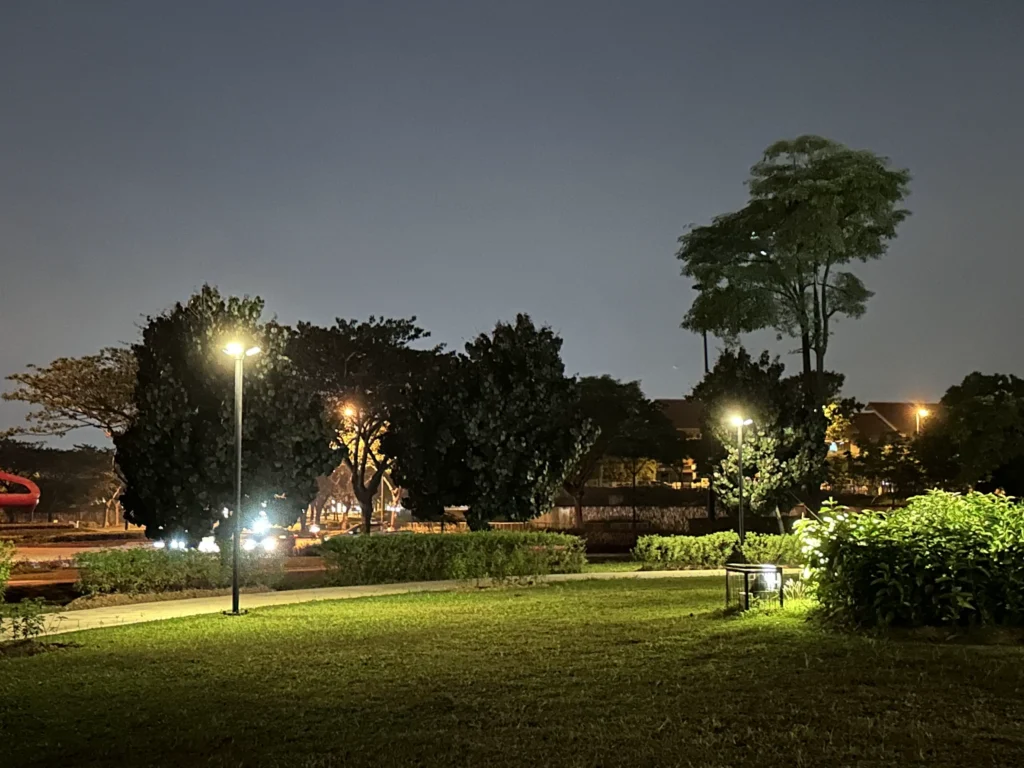Abstract
This case study details the successful deployment of 188 SRESKY UFO Series solar landscape lights in the lighting upgrade project at Shah Alam State Government Park, Malaysia. Addressing multiple requirements—enhancing park nighttime safety, reducing operational costs, and aligning with national sustainable development strategies—the project leveraged advanced solar lighting technology. This approach not only achieved zero electricity costs and low maintenance for park illumination but also significantly improved citizens’ nighttime recreational experiences and perceptions of public safety.

I. Project Background and Requirements Analysis
1.1 Project Background
Located in the heart of Selangor State, Malaysia, Shah Alam State Government Park serves as a vital venue for daily recreation, fitness, and social activities for local residents. As an expansive public green space, its aging lighting system could no longer meet modern demands amid urban expansion and increased nighttime activity. In response to Malaysia’s “Green City and Low Carbon Community” initiative, the park management launched a lighting system modernization project.
1.2 Core Requirements and Challenge Analysis
The requirements analysis identified four key challenges:
-
Sustainability goals: Park management mandated 100% clean energy adoption to eliminate reliance on the traditional grid, reduce carbon footprint, and demonstrate governmental environmental leadership.
-
Operational cost pressures: Traditional high-pressure sodium or metal halide lamps consumed vast amounts of electricity, incurring annual bills of tens of thousands of dollars. Frequent bulb replacements also drove up maintenance costs.
-
Public safety and nighttime experience: The existing system suffered from uneven illumination, severe light decay, and high failure rates. Dimly lit areas created safety hazards, limiting nighttime use and failing to meet citizens’ growing demand for evening activities.
-
Climate adaptability: Located in a tropical rainforest climate zone, Malaysia faces year-round high temperatures, humidity, and a prolonged rainy season (annual rainfall >2000 mm). New lighting equipment had to withstand high heat (average >30°C), high humidity, and extended rainfall—factors that strain batteries, solar panels, and control systems.
The SRESKY UFO Series solar landscape lights were specifically engineered to address these challenges. Core technologies like ALS and TCS ensure stable operation in complex environments, providing a reliable technical pathway for projects in similar tropical regions.

II. Technical Solution Design
2.1 Product Selection
Following rigorous technical evaluations and supplier comparisons, the project selected 188 units of the SRESKY UFO Series solar landscape lights. Known for its innovative circular UFO design and 2000-lumen high brightness, this fixture is ideal for large public spaces such as parks, plazas, and landscaped areas.
2.2 Technical Compatibility Analysis
The UFO Series demonstrates compatibility across multiple dimensions:
-
Omnidirectional illumination: The unique circular design and LED beads deliver 360° coverage without blind spots. This complements the open layout of parks, providing uniform, soft illumination (5700K, CRI Ra>70) for paths, lawns, water features, and facilities. It eliminates shadowed areas, improving visibility and aesthetics. Field deployment confirmed comfortable illumination across both main thoroughfares and secluded corners, resolving the “light island” problem common with traditional fixtures.
-
Reliability in extreme weather:
-
ALS 2.4 Smart Light Control: This adaptive system adjusts power consumption based on ambient light and battery levels, guaranteeing over 10 days of illumination during prolonged rainy periods. By dynamically adjusting brightness (100%–15%), ALS maximizes efficiency, far surpassing the 3–5 day endurance of conventional solar lights.
-
TCS Smart Temperature Control: Designed for Malaysia’s heat, TCS continuously monitors battery temperature to prevent degradation. The lithium-ion battery’s charge/discharge range (-10°C to 60°C) ensures thousands of cycles in hot conditions. Compared to standard lithium batteries, TCS reduces high-temperature capacity loss by over 50%.
-
-
Efficient power system: Equipped with high-conversion monocrystalline solar panels, the lights fully charge in just 6.7 hours, maximizing daylight use.
-
Durability: The lamp body, made from aluminum alloy + PC material, is IP65 waterproof/dustproof and IK08 impact-resistant, ensuring resilience against weather and vandalism. Recommended installation height is 3 meters with 10-meter spacing, optimizing both coverage and safety.
These technical features not only guarantee project reliability but also provide strong reference data for clients.

III. Project Implementation and Execution
3.1 Deployment Strategy
A total of 188 UFO Series solar landscape lights were installed along main pathways, secondary trails, rest areas, music pavilion surroundings, and near water features. Deployment considered both traffic distribution and aesthetics—using higher brightness in busy zones and energy-saving modes in quieter areas. Wireless installation minimized excavation, preserving the park’s ecology.
3.2 System Commissioning
Staff configured lighting modes using a universal remote. Preset modes include:
-
M1: 15% brightness until dawn
-
M2: 30% brightness for 5 hours + 15% until dawn
-
M3: 35% brightness until dawn
-
100% timed brightness function
Capacity indicators (green >70%, orange 30–70%, red 10–30%) simplified monitoring, ensuring stable operation.

IV. Project Outcomes and Impact
4.1 Social Value
-
Public safety: Uniform illumination reduced crime risks and gave residents greater peace of mind.
-
Community vitality: Increased nighttime activity—walking, jogging, and socializing—revitalized the park, boosting quality of life.
-
Urban image: Modern solar lights blended with natural landscapes, creating attractive nightscapes that enhanced Shah Alam’s reputation.
4.2 Economic Benefits
-
Zero electricity costs: The park saved tens of thousands of dollars annually.
-
Lower maintenance: Reliable design minimized repairs, while long-life LEDs reduced replacements. Clients typically achieve ROI in 2–3 years.
4.3 Environmental Sustainability
-
Carbon reduction: 188 luminaires cut annual CO₂ emissions by dozens of tons, equivalent to planting hundreds of trees.
-
Regional impact: The project set a benchmark for green energy adoption, promoting solar technology in Southeast Asia.
Conclusion
The solar lighting retrofit at Shah Alam State Government Park exemplifies the successful integration of technology, social value, and environmental responsibility. By deploying the SRESKY UFO Series solar landscape lights, the project resolved the limitations of traditional systems while significantly enhancing the service value of public spaces in a sustainable way.
Table of Contents